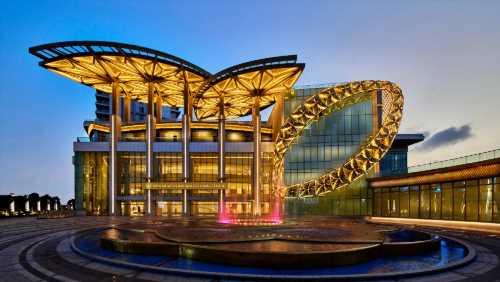
The popular Jio MAMI Mumbai Film Festival is returning after a three-year COVID and logistics-related absence with a hub, a refreshed executive team and a host of plans.
Hollywood and Bollywood star Priyanka Chopra Jonas continues as festival chair, while media veteran and former Variety contributor Anupama Chopra remains festival director and independent producer Anu Rangachar (Locarno title “Rapture”) heads up the international program. Alongside them is a new team including Deepti DCunha, who previously advised Cannes and Film Bazaar, as artistic director; former Lionsgate India content head Maitreyee Dasgupta as co-director; producer Anupama Bose (Rotterdam title “Joram”) as artistic director, Jio MAMI year round program; and Abhishek Kumar as head of marketing, PR and sponsorship.
Billionaire Mukesh Ambani’s media conglomerate Jio remains the title sponsor of the festival, which is operated by the the Mumbai Academy of Moving Image (MAMI). The new, glittering Nita Mukesh Ambani Cultural Centre will be the festival hub. The venue is home to three performing arts spaces: the 2,000-seater Grand Theatre, the 250-seater Studio Theatre and the 125-seater Cube. PVR Inox, India’s largest multiplex chain, remains the primary screening venue partner.
“We’ve come back not as a small festival — in fact, we are coming back bigger and with an expanded vision, because I think we realized that people have been waiting for a film festival,” DCunha told Variety, adding that after a couple of digital editions, filmmakers were thirsting to show their work on the big screen. Several films selected for the festival’s past digital editions will get big screen outings this year.
Mumbai, India’s financial capital, is home to the Hindi-language Bollywood industry and is one of the top three filmmaking centers in the country alongside Hyderabad and Chennai. The hub, which is well connected to the rest of the city, plugs the need for a central venue that was lacking in previous editions. It will host panel discussions, including on sustainable producing and around gender and cinema. It will also be the location for a brand marketplace.
The festival, which was hitherto focused on discovering Indian films and filmmakers, has pivoted to becoming one that spotlights South Asian talent, meaning films from India’s neighbors will also be showcased. “We believe there’s some exceptional work being done by South Asian and South Asian diaspora filmmakers,” DCunha said. “We want to discover fresh South Asian talent and nurture and support the spirit of independent filmmaking. We look forward to creating a hub for South Asian filmmakers to make and sustain connections with their peers and form a community.”
The South Asian films selected are required to be regional premieres. “We not only bring the best stories and creators from around the world to Mumbai, but also provide an excellent platform for filmmakers to collaborate and explore the business of filmmaking. Through this year’s edition, the institution aims to develop new talent by facilitating knowledge sharing in the different aspects of filmmaking, both during the festival and the year round program,” Dasgupta said.
To create buzz around the South Asian films, the festival is starting a press center from this year that will be home to both Indian and international journalists. “What we’re ensuring is that every filmmaker that comes over to the festival gets just the right kind of PR and media coverage and really gets the opportunity to walk the red carpet and own the moment after the premiere of their film,” Kumar said.
The addition of the hub has also prompted the revival of the film market, which existed for a few years at a suburban venue before being discontinued. “The market is going to proceed slowly, because we do know that we need enough buzz on the South Asian films before the international distributors step in to buy them. We’ll be calling festival directors and programmers because that is the way into international distribution directly than a full-fledged market like Cannes,” DCunha said.
The market is also looking at getting international films Indian distribution. India is well-served by domestic content and Hollywood films account for only 10% of the market. Global arthouse cinema distribution is in a nascent stage, with minimal presence from Indian distributors in the top international markets. The MAMI market aims to gather distributors from around India to acquire international films.
“The idea is to definitely get the buzziest titles from around the world to the festival, but at the same time, we are cognizant of the fact that festivals are a great platform for audiences to discover not-so-known talent and cinema, and therefore, we are also focused on bringing unknown gems to the festival and surprising our audiences,” Rangachar said.
This year, some of the festival’s key components, like the young critics lab and the books-to-screen market, will happen in the run up to the festival. The year-round program, which screens films through the year, ensures that MAMI stays top of mind for audiences while feeding them world-class cinema. “The programming vision would include meticulously curated films and filmmakers, a deep dive into their filmmaking processes, and a conscious engagement with world best practices, leading to an outreach within the community as well as within viewers to enable and enhance ease of creation, business, and a more cinema-aware audience,” Bose said.
As in past years, the 2023 edition will see the participation of global streamers Netflix, Disney+ Hotstar and Prime Video, all of whom have their India headquarters in Mumbai.
“Our unflinching commitment to independent films and filmmakers is the driving force behind the festival, and we can’t wait to experience the festival in a few months. This is where cultures meet and cinephiles get to experience myriad emotions, and we are happy to be a catalyst in making this possible,” Chopra said.
The festival takes place Oct. 27-Nov. 5.

Read More About:
Source: Read Full Article